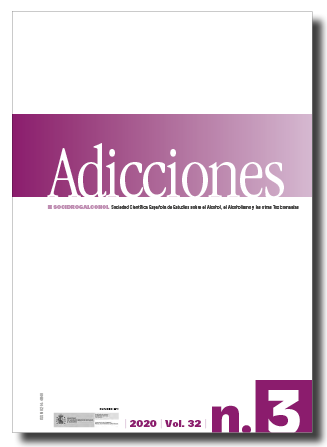Visual attention to alcohol labels: an exploratory eye-tracking experiment
DOI:
https://doi.org/10.20882/adicciones.1207Keywords:
Alcohol, Labelling, Health warning, Attention, Eye-tracking.Abstract
Current alcohol labelling goes unnoticed by consumers. In addition, EU legislation does not obligate the alcohol industry to include any health warning labels on alcohol packagings. This study aims to explore how the size and design of alcohol by volume (ABV) labels, along with the alcohol strength presented on these labels, influence visual attention toward them. We also examine how label size and alcohol strength influence visual attention toward a health warning label on alcoholic beverages. Using an experimental human laboratory design, we tracked the eye-movements of 64 participants while they viewed beers with different ABV (0.4%, 4.6% vs. 15%). We measured the number of fixations toward ABV labelling which varied in size and design (text-only vs. traffic light). A health warning label was also included on the beers for half of the participants and size was manipulated as a between-subject factor. Results showed strong evidence that the number of fixations was higher when the ABV labels were larger and used a traffic light system. Likewise, we found a higher number of fixations toward larger health warning labels and differences in visual attention depending on the ABV content presented. In conclusion, this study indicates that current alcohol labelling is insufficient to draw the attention of consumers and suggests that future alcohol labelling must be larger and with a graphic design to attract attention.References
Anderson, P., Cremona, A., Paton, A., Turner, C. y Wallace, P. (1993). The risk of alcohol. Addiction, 88, 1493-1508. doi:10.1111/j.1360-0443.1993.tb03135.x.
Anderson, P., Moller, L., Galea, G. y World Health Organization (Eds.). (2012). Alcohol in the European Union: consumption, harm and policy approaches. Copenhagen, Denmark: World Health Organization Regional Office for Europe.
Babor, T. F., Higgins-Biddle, J. C., Saunders, J. B. y Monteiro, M. G. (2001). The Alcohol Use Disorders Identification Test: Guidelines for use in. 2nd ed. World Health Organization. Recuperado de https://apps.who.int/iris/handle/10665/67205.
Blackwell, A. K. M., Drax, K., Attwood, A. S., Munafo, M.R. y Maynard, O. M. (2018). Informing drinkers: Can current UK alcohol labels be improved? Drug and Alcohol Dependence, 192, 163–170. doi:10.1016/j.drugalcdep.2018.07.032.
Congreso de los Diputados. (2018, April 24). Comision Mixta para el Estudio del Problema de las Drogas Sesion no 10 24/04/2018. Recuperado de http://www.congreso.es/wc/wc/audiovisualdetalledisponible?codSesion=10&-codOrgano=322&fechaSesion=24/04/2018&mp4=mp4&idLegislaturaElegida=12.
European Union Committee. (2015). A New EU Alcohol Strategy? Recuperado de https://publications.parliament. uk/pa/ld201415/ldselect/ldeucom/123/12302.htm.
Farke, W. (2011). Health warnings and responsibility messages on alcoholic beverages–a review of practices in Europe. Mainz Germany: German Catholic University of Applied Sciences.
Graham, D. J., Orquin, J. L. y Visschers, V. H. M. (2012). Eye tracking and nutrition label use: A review of the literature and recommendations for label enhancement. Food Policy, 37, 378–382. doi:10.1016/j.foodpol.2012.03.004.
Hammond, D. (2011). Health warning messages on tobacco products: a review. Tobacco Control, 20, 327–337. doi:10.1136/tc.2010.037630.
Kersbergen, I. y Field, M. (2017). Alcohol consumers’ attention to warning labels and brand information on alcohol packaging: Findings from cross-sectional and experimental studies. BMC Public Health, 17. doi:10.1186/s12889-017-4055-8.
Maynard, O. M., Attwood, A., O’Brien, L., Brooks, S., Hedge, C., Leonards, U. y Munafo, M. R. (2014). Avoidance of cigarette pack health warnings among regular cigarette smokers. Drug and Alcohol Dependence, 136, 170–174. doi:10.1016/j.drugalcdep.2014.01.001.
Noar, S. M., Hall, M. G., Francis, D. B., Ribisl, K. M., Pepper, J. K. y Brewer, N. T. (2015). Pictorial cigarette pack warnings: a meta-analysis of experimental studies. Tobacco Control, 25, 341–354. doi:10.1136/tobaccocontrol-2014-051978.
Parlamento Europeo y del Consejo. Reglamento (UE)
nº 1169/2011 del Parlamento Europeo y del Consejo de 25 de octubre de 2011 sobre la informacion alimentaria facilitada al consumidor y por el que se modifican los Reglamentos (CE) nº 1924/2006 y (CE) nº 1925/2006 del Parlamento Europeo y del Consejo, y por el que se derogan la Directiva 87/250/CEE de la Comision, la Directiva 90/496/CEE del Consejo, la Directiva 1999/10/CE de la Comisión, la Directiva 2000/13/CE del Parlamento Europeo y del Consejo, las Directivas 2002/67/CE, y 2008/5/CE de la Comision, y el Reglamento (CE) nº 608/2004 de la Comision, Pub. L. nº 1169, 46 (2011). Recuperado de https://www.boe.es/doue/2011/304/L00018-00063.pdf.
Saunders, J. B., Aasland, O. G., Babor, T. F., Fuente, J. R. D. L. y Grant, M. (1993). Development of the Alcohol Use Disorders Identification Test (AUDIT): WHO Collaborative Project on Early Detection of Persons with Harmful Alcohol Consumption - II. Addiction, 88, 791–804. doi:10.1111/j.1360-0443.1993.tb02093.x.
Thomsen, S. R. y Fulton, K. (2007). Adolescents’ Attention to Responsibility Messages in Magazine Alcohol Advertisements: An Eye-Tracking Approach. Journal of Adolescent Health, 41, 27–34. doi:10.1016/j.jadohealth.2007.02.014.
Thomson, L. M., Vandenberg, B. y Fitzgerald, J. L. (2012). An exploratory study of drinkers views of health information and warning labels on alcohol containers: Warning labels on alcohol containers. Drug and Alcohol Review, 31, 240–247. doi:10.1111/j.1465-3362.2011.00343.x.
Truitt, L., Hamilton, W. L., Johnston, P. R., Bacani, C. P., Crawford, S. O., Hozik, L. y Celebucki, C. (2002). Recall of health warnings in smokeless tobacco ads. Tobacco Control, 11, ii59–ii63. doi:10.1136/tc.11.suppl_2.ii59.
Villalbi, J. R., Espelt, A., Sureda, X., Bosque-Prous, M., Teixido-Compano, E., Puigcorbe, S., … Brugal, M. T. (2019). The urban environment of alcohol: a study on the availability, promotion and visibility of its use in the neighborhoods of Barcelona. Adicciones, 31, 33-40. doi:10.20882/adicciones.950.
Wedel, M. y Pieters, R. (2008). A review of eye-tracking research in marketing. En Review of marketing research (pp. 123-147). Emerald Group Publishing Limited.
Wilkinson, C., Allsop, S., Cail, D., Chikritzhs, T., Daube, M., Kirby, G. y Mattick, R. (2009). Alcohol Warning Labels: Evidence of impact on alcohol consumption amongst women of childbearing age. Food Standards Australia New Zealand, Canberra.
Wilkinson, C. y Room, R. (2009). Warnings on alcohol-containers and advertisements: international experience and evidence on effects. Drug and Alcohol Review, 28, 426–435. doi:10.1111/j.1465-3362.2009.00055.x.








